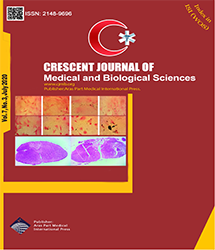| Original Article | |
| Molecular Fingerprinting and Occurrence of blaKPC and blaOXA-48 in Klebsiella pneumoniae Isolated From Clinical Specimens, Khorramabad, Iran | |
| Gholamreza Goudarzi1, Pegah Shakib1, Khatereh Anbari2, Shahram Shokri3 | |
| 1Razi Herbal Medicines Research Center, Lorestan University of Medical Sciences, Khorramabad, Iran 2Department of Community Medicine, Lorestan University of Medical Sciences, Khorramabad, Irann. 3Department of Infectious Diseases, Lorestan University of Medical Sciences, Khorramabad, Iran |
|
|
CJMB 2020; 7: 348-354 Viewed : 16840 times Downloaded : 2901 times. Keywords : Carbapenemase, Klebsiella pneumoniae, blaOXA-48, blaKPC |
|
| Full Text(PDF) | Related Articles | |
| Abstract | |
Objectives: Carbapenem-resistant Klebsiella pneumoniae (CR-Kp) is created by various mechanisms mainly including the production of Klebsiella pneumoniae carbapenemase (KPC) and other class A, B, and D beta-lactamases (e.g., OXA-48). The present study was undertaken to assess the occurrence of blaKPC and blaOXA-48 genes among K. pneumoniae isolates. Materials and Methods: In this cross-sectional study, 110 K. pneumoniae strains were collected from clinical samples from 2 teaching hospitals in Khorramabad, Iran. Susceptibility testing and modified-Hodge test (MHT) for K. pneumoniae isolates were performed according to Clinical and Laboratory Standards Institute procedures, followed by carrying out the detection of blaKPC and blaOXA-48 genes by polymerase chain reaction (PCR). Finally, genetic similarity among the tested strains tested was determined by the repetitive extragenic palindromic PCR (rep-PCR) method. Results: Up to 110 K. pneumoniae, the highest resistance and susceptibility rates pertained to ampicillin and ertapenem, respectively. In addition, 10 (9%) isolates were considered as carbapenemase-producing K. pneumoniae by the MHT. Although 13 (11.8%) isolates were blaOXA-48-positive, none of them were harboring blaKPC. Eventually, 13 and 44 clusters were distinguished in hospitals A and B by rep-PCR, respectively. Conclusions: The results of this study indicated that resistance to carbapenems among K. pneumoniae isolates were relatively common in our region. Moreover, the disseminated clones in our hospitals had mainly diverse origins. |
Cite By, Google Scholar
PubMed
Online Submission System
 CJMB ENDNOTE ® Style
CJMB ENDNOTE ® Style
 Tutorials
Tutorials
 Publication Charge
Medical and Biological Research Center
About Journal
Publication Charge
Medical and Biological Research Center
About Journal
Aras Part Medical International Press Editor-in-Chief
Arash Khaki
Deputy Editor
Zafer Akan


















